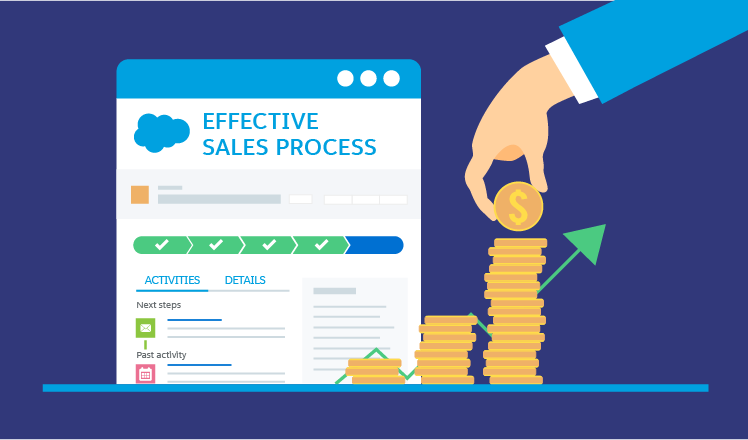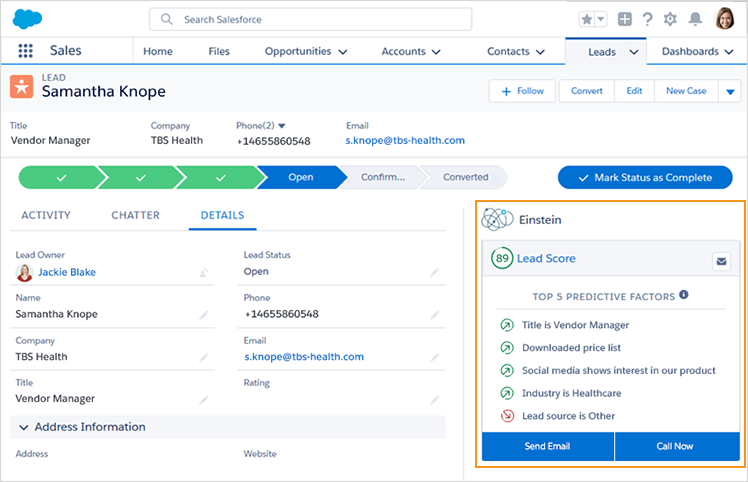How to achieve a more effective sales process through Salesforce
Editor's note: A CRM implementation company with experience in the field since 2008, ScienceSoft describes the role of a CRM system (we took Salesforce as an example) in a typical sales process.
The product doesn’t sell itself no matter how good it is. Therefore, with the modern technology getting smarter and customers becoming more sophisticated, businesses should be able to adopt technological innovations and benefit from them. In this article, we will look into how Salesforce implementation can streamline the sales process using Sales Cloud as an example.
Let's find out how Salesforce Sales Cloud helps to
- Qualify leads & conduct needs assessment
- Prepare a proposal
- Handle objections
- Close a deal
- Follow-up
- Understand competition

1. Lead qualification & needs assessment
Lead qualification is a part and parcel of the sales process. At this stage, gathering the customer’s data is crucial in order to be able to effectively qualify your lead. In this regard, the value of CRM tools can hardly be overestimated.
- Salesforce Sales Cloud allows creating a complete customer profile, tracking such information as contacts and important relationships. This option is effective in that it helps not only to qualify leads more reliably, but also to gain a better understanding of their needs. In addition, it saves your sales reps’ time preventing them from copying and pasting from different documents or searching for necessary data stored in silos.
- Gathering and analyzing data from social media is essential to help sales reps pick the leads to focus on rather than waste time on those that will never convert. Besides, it helps sales reps to better understand the prospects’ needs and expectations regarding a potential deal. Having a look at social network profiles associated with Salesforce accounts, contacts, and leads allows gathering social intelligence easier and faster to qualify leads and prospects, as well as to better understand the needs of current and potential customers.
- Einstein Lead Scoring allows prioritizing leads based on their sales readiness. This indicator varies depending on the interest a lead shows in your business, a lead’s current place in the buying cycle as well as its fit with your defined buyer persona. Using a lead scoring system, sales reps can benefit from identifying ‘hot’ leads and distinguishing leads that need further nurturing. This tool is built using data science and machine learning to discover lead conversion patterns, and to predict which current leads to prioritize. By using machine learning, Einstein Lead Scoring provides a faster and more accurate solution than traditional rule-based lead scoring approaches. Einstein analyzes past leads to determine which current leads have the most in common with leads that have successfully converted in the past. Based on this analysis, Einstein creates a predictive model, reanalyzes sales data every month and refreshes the model.

Einstein Lead Scoring
2. Proposal
Conceiving a proposal tailored to your potential customer’s specific needs without having deep knowledge about them is like groping in the dark. A common mistake a lot of businesses make in the absence of crucial customer data is proceeding with a proposal from the seller’s perspective, such as turning a sales presentation into a self-aggrandizing monologue rather than focusing on what benefits their product brings to the customer.
- The Salesforce Sales Cloud functionality comes in handy for proposal creation, as well. Based on the needs assessment carried out at the first stage, coming up with a customized quotation, in case of simple transactional sales, does not require much effort. Storing customer-related data in Salesforce allows sales reps to determine what product will suit the customers best and even anticipate their needs. Such an approach inevitably contributes to positive customer experience.
- Salesforce allows creating a quote from an opportunity and its products, while each opportunity can have multiple quotes and any of them can be synced with the opportunity. In Salesforce, your sales reps can create a set of quotes to show different combinations of products, quantities, and discounts so that customers can compare prices. The platform also allows creating quote PDFs from a standard template or the design that your company comes up with, and email them to the customers.
- Creating Opportunity teams in Salesforce Sales Cloud allows cooperation of employees from different departments, for example, from engineering and marketing, who help a sales rep and whose participation is absolutely critical for complex proposals.
- Proposal preparation may require asking a customer many questions on the way that is facilitated by Salesforce. Answers to the questions are entered and saved in Salesforce, thus enabling a sales rep to see full information about the customer to draft a tailored proposal. All customer information relevant to a proposal is accumulated in Salesforce Database, in Leads or Contacts objects which contain fields for storing the important customer data.
3. Handling objections
A sale going smoothly is an ideal scenario for all sales reps. However, it is mere utopia. In reality, the majority of sales go hand in hand with objections.
Common types of objections sales reps encounter and solutions provided by Salesforce Sales Cloud:
- Need: Your prospect may say they don’t need your product, which can be true to some extent unless they have too little information about it. The sales rep’s task in this case comes down to communicating the pros of the solution they offer and showing how the prospect can benefit from adopting it. This can be done by sharing success stories and testimonials. Also, Salesforce can be used to create demos of products to show their capabilities and benefits.
- Budget: When it comes to pricing, prospects always seem to be full of doubts. A sales rep can overcome this issue by drawing the prospect’s attention to the product’s value as well as by proposing a solution that fits their prospect’s budget best. Here, the Salesforce functionality can be of great help as it allows to bring all knowledge about your customer under one umbrella ꟷ generating a 360-degree customer view allows gaining a better understanding of their preferences. It’s also possible to profile customers by price sensitivity by adding a custom attribute based on the experience from previous opportunities that may have been lost due to high price.
- Time: If the tactics ‘buy right now, or you’ll regret’ proves to be ineffective, the best way to overcome this objection will be to give the prospect pause for thought while remaining in contact with them. In Salesforce, your sales reps plan future communication to respond to the prospects’ concerns effectively. The platform allows setting a nurturing schedule so that a sales rep with, say, 50 accounts pending may appreciate having Salesforce reminding the sales rep to contact one account or another.
4. Closing
Gone are the days when closing a deal was just a matter of verbal communication and a handshake. Today’s customers are more sophisticated and meticulous, which requires more effort on sales reps’ part to persuade them. The right CRM software not only allows increasing your sales through efficient communication with customers, but also gives an insight into the customer’s purchasing habits. For example, Sales Cloud Einstein analyzes customer data to learn what separates deals won from deals lost, and identifies the next steps to close.
- Einstein Opportunity Scoring automatically prioritizes high-value opportunities directly within Sales Cloud based on the record details, history, related activities of the opportunity and related account. Using this tool enables sales reps to focus on the deals that are most likely to close and add resources to deals that may be at risk.
- With Einstein Opportunity Insights, sales reps can get relevant updates about their opportunities to close more deals. This tool includes predictions about which deals are likely to be won, reminders to follow up, and notifications when key moments in a deal take place.
- As a fully automated, out-of-the-box solution, Einstein Forecasting uses all of a company's historical CRM data to take the guesswork out of forecasting. Instead of relying on random spreadsheets and outdated systems to forecast sales projections, which often results in inaccurate forecasts and deals lost, sales reps can benefit from closing deals faster relying on the tool’s capability to make highly accurate and tailored sales forecasts.
The key to effective selling includes understanding your clients, knowing when a prospect is ready to close, and having sufficient data at disposal. Powered by Einstein, Salesforce Sales Cloud supports all of these.
5. Follow-up
Having your sale closed doesn’t mean having your job done. In fact, it is only the beginning of your fruitful cooperation with the customer, provided you manage to maintain your relationship. Since retaining the existing customers is significantly cheaper than acquiring new ones, nurturing and maintaining relationships is crucial.
In Salesforce Sales Cloud, sales reps can add a follow-up and choose the due date for an important email or meeting so that they could proactively go back to the customer. Sales reps can invite people to meetings and see meeting responses in Lightning Experience, Salesforce Classic, and the Salesforce mobile app. Sales reps can also create a Microsoft Outlook appointment for an event in Salesforce Classic. Salesforce displays event and task reminders in a reminder window. Reminders can be customized in personal settings.
If the deal is won, the contract is signed, and you can continue the client onboarding process. However, even in case the deal is lost, it is important to keep track of those, too. Salesforce allows keeping a record of lost deals throughout the sales stages so that your sales reps can analyze why those deals were lost, or revisit them in the future to potentially turn them to their benefit.
While following up effectively without being bothersome can be difficult, John Barrows, a sales trainer for Salesforce and a number of leading tech companies, has come up with five tips for effective follow-ups:
- Ask your customer how they prefer to stay in touch. Knowing this information enables a sales rep to promptly communicate with the customer (via email, phone or texting a message). Salesforce makes it possible to store the customer’s preferences in a Contact/Lead record.
- Ask what their preferred means of communication is. Salesforce allows a sales rep to save the customer’s answer in a Contact/Lead object and refer to it every time they need, for example, in case of a discount program.
- End each conversation with your customer with a clearly defined next step. Upon determining the next step with the customer, Salesforce allows creating a task or event for this step and sending the corresponding notification to the sales rep.
- Summarize your conversations and get written confirmations.
- Do not reach your customer without a reason.
Bearing in mind these tips coupled with the use of Salesforce Sales Cloud ensures the follow-up is effective and yields desired results.
6. Understanding competition
Understanding who your competitors are and what competitive advantages they have to offer can help you keep abreast of where you may need to add to maintain your competitive edge and make your products and services stand out. This knowledge will help you to respond to your competitors’ initiatives with those of your own. The ways of tracking your competitors are numerous but painstaking:
- Reviewing how your competitors reach their customers
- Reviewing your competitors’ websites
- Understanding pricing and special offers
- Following competitors on social media
- Buying directly from your competitor, etc.
Meanwhile, Salesforce Sales Cloud allows tracking competitors in a pending sale by listing the competitors’ names in the opportunity. The Salesforce functionality allows entering the names of new competitors, or choose from a list of competitors defined by an administrator. To access this information, you need to go to the competitors’ related list of the opportunity. Creating a picklist of competitors that sales reps can attach to opportunities allows reusing info about them, which is especially relevant in case a company encounters the same competitors again and again.
Such a capability undoubtedly makes monitoring competition easier. Sales reps can gather corporate details about the competitor, such as their name, target market, pricing, customer rating, etc. Details include why this competitor is considered, what the prospect said about the competitor, and what the prospect sees as their strengths and weaknesses. In addition, the Selling Tips, Our Advantages, Competitor Weaknesses, and other data from the competitor record are displayed on the Opportunity Competitor to help your sales reps pivot their strategy to beat particular competitors.
In a nutshell
Boosting your sales process requires investing in the right tools and smart technology. In this regard, Salesforce Sales Cloud has the capabilities to help you successfully manage your sales process ꟷ throughout the stages of qualifying and need assessment to closing and follow-up. In case your company has specific sales stages that differ from standard ones, it makes sense to customize opportunity stages to the company’s individual sales process to enjoy more benefits.

